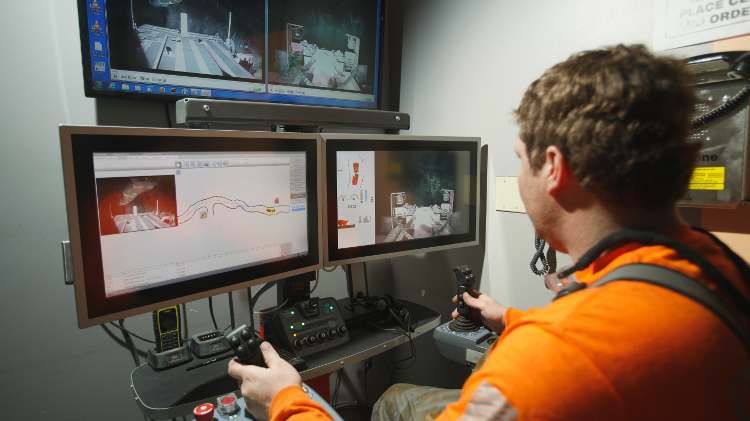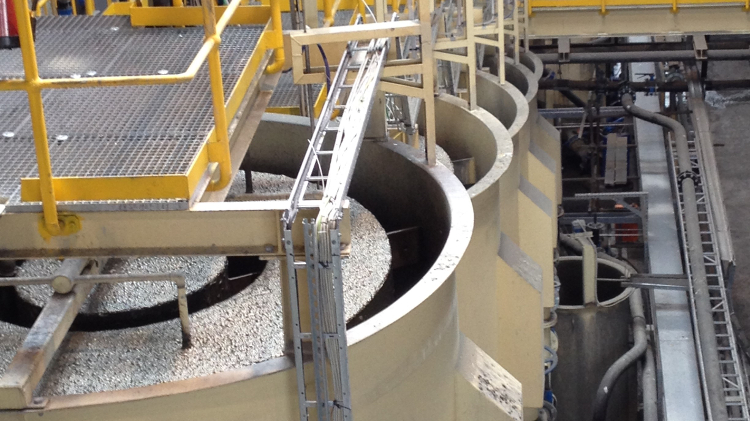Cameco began developing the jet boring system used at Cigar Lake in the early 1990s | Courtesy of Cameco
In December, Cameco announced it had begun jet boring the ore at its Cigar Lake uranium mine in northern Saskatchewan. The announcement marked the launch of a new mining method, with technology designed specifically for the unique deposit that was more than 20 years in the making and cost $2.6 billion to develop.
“No one thought it possible to mine such a difficult ore body,” says Uwe Restner from Sandvik Mining, whose company has worked closely with Cameco to manufacture the system that has made mining at Cigar Lake feasible. “Cameco had a lot of courage to take a nearly impossible vision and turn it into a possible mission.”
Discovered in 1981, Cigar Lake contains an estimated 217 million pounds of high-grade uranium, making it the world’s second largest deposit of its kind. Cameco expects a 15-year mine life from the current Reserves, with daily production capacity ramping up to between 100 and 140 tonnes. But getting to that point is an incredibly challenging feat: reaching down some 450 metres below surface, the ore body is in water-bearing sandstone overlying basement rock. To add to the complexities and risk, the water is under hydrostatic pressure, increasing the chance of the mine flooding. And if that were not enough, there are also the issues of weak rock formations and a high-radiation environment. The challenges, at one time, seemed insurmountable.
But since the early 1990s, Cigar Lake’s owners have been committed to mining the deposit. Cameco, supported by its joint venture partners, set out to develop a new mining method that could safely and successfully extract the uranium where conventional methods could not, due to the water and ground instability issues. Researchers conducted underground tests in the ore body in 1992, comparing various methods and, one year later, they concluded jet boring had the most potential. The method uses water under high pressure to carve out cavities in the ore body. The resulting ore slurry is then collected through a network of pipes.
To use the jet boring system (JBS) effectively, Cameco had to deal first with all of the water surrounding the deposit. For this, they began freezing the ore body, which stabilizes ground conditions and prevents water inflow while also improving workers’ protection from radiation. Cameco built a system with an ammonia refrigeration plant on the surface – used for the surface and underground freeze systems – a surface and underground brine piping system, and in-situ freeze pipes.
Jet boring borrows from a variety of technologies including high-pressure jetting used in the oil sands, combined with other proven drilling methods employed in the mining and oil industries. By 2000, Cigar Lake’s first prototype JBS was in place. As hoped, further tests established that the system would function, in principle. And then the real work began.
Working through setbacks
By 2005, Cigar Lake was ready for construction. With Cameco and Sandvik working closely together, a second JBS system was installed, taking into consideration lessons learned from the previous one. “The principle system for the jet boring has stayed more or less the same over time,” says Restner. “You drill, put in the casings and then you start the jetting operation so you jet out the ore with the high-pressure water.”
Unfortunately, in October 2006, the project faced a major setback when the mine workings flooded after a fall of ground in an area of the mine under development. Then in August 2008, another water inflow occurred in a different part of the mine while it was being dewatered. After the first flooding incident, Cameco took a step back and began re-evaluating and revising the mine design and practices to minimize water inflow risk. After the second event, this became an even higher priority. Changes included a revamped mine dewatering system comprised of three main pumping systems with a pumping capacity of 2,500 cubic metres per hour, provided by high-speed multi-stage centrifugal pumps that can handle both the daily routine dewatering requirements as well as non-routine inflows.
Best technologies combined
“Sometimes the most innovative work is the stuff that plagiarizes, for lack of a better word, technologies from various sources and puts them together into one package,” says Steve Lowen, general manager at Cigar Lake. “We have tried to take the practices from the oil sands, along with the processing system designs that deal with radioactive materials that have been developed at McArthur River and elsewhere. Really, the innovation is the combination of all the best pieces put into one package.”
Lowen notes that Cameco benefitted from past experiences at its McArthur River uranium mine. “In fact, we used some of the same people engaged in the McArthur River start-up at Cigar, so it has been a good application of experience and learning from our other mine sites.”
Ore collected by the JBS at Cigar Lake is put through an underground grinding and thickening circuit and then pumped to surface as slurry. From there, the ore is loaded in containers for truck transport to the mill. To address the risk of radon gas exposure (a progeny byproduct from uranium), the entire system is closed. The JBS itself has radiation monitoring equipment installed. “You never see uranium in the open,” explains Lowen. “It’s always in enclosed pipes and is away from the workers.”
Bringing together technologies from a variety of fields wound up being the project managers’ greatest challenge. “The most important thing with the first JBS system was to prove they could cut out this high-grade ore with a high-pressured water jet,” says Restner. “Then, of course, they had to look at how the mine would be set up, so looking at the entire system. It isn’t just an excavation system. The system is fully integrated into the mine infrastructure.”
Cigar Lake will eventually have four JBS units on site, with each new one being improved upon by the lessons of the previous iteration. The mine will be capable of hitting full production capacity with two units in operation.
Currently, Sandvik is working on the third variant of the JBS. “In the first system, the controls were very basic, but in the second and third units, there is a lot more integration and automation and it’s all in the cabin so the operator of the JBS has access to not just its operation but also the controls for the mine’s infrastructure,” says Restner. “For example, this includes complete control of the high-pressure pumps and related systems. The first system is now being retrofitted with these improvements as well.”
Powering Cigar Lake’s jet boring system is a highly sophisticated computer network, in which each computer can take over the master control of the others, depending on what is needed. “It makes it quite complicated and the entire electrical system has to be in good shape because any disconnections could affect the communication between the different systems,” says Restner. “The JBS itself also consists of a lot of different components and sub-systems that have to work together and digitally speak with each other. With all this interlinking, you have to make sure all the components are working. You can’t have a weak link in the chain, as it will disturb the entire system.”
With construction completed and mining beginning, workers on the project have moved on to a new learning curve. “What we’ve done to date is prove the technology does work safely, that we can get a stable cavity and the very basics of the system work effectively in the first cavity,” Lowen says. “Now we just have to do this repeatedly over the next few years to prove we can actually get our design capacity, making whatever efficiency modifications we need to make, but I am confident we’ll be able to do that.”




